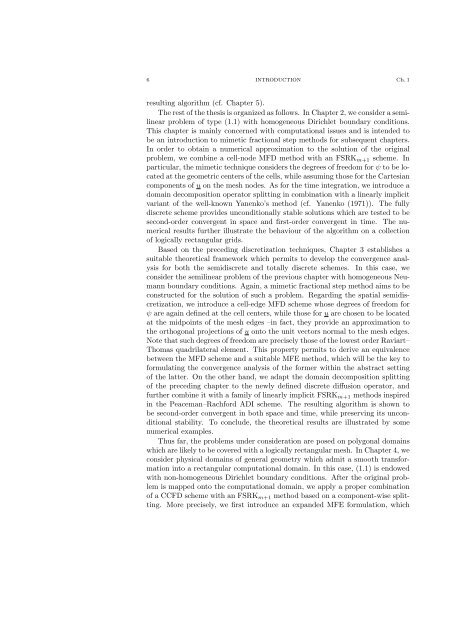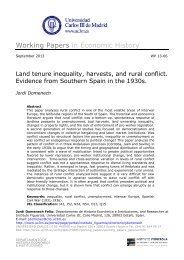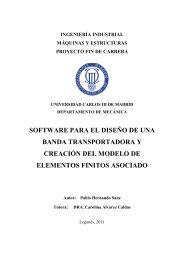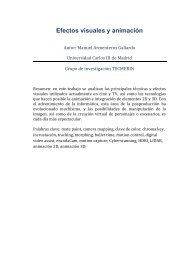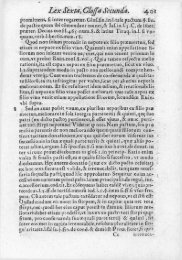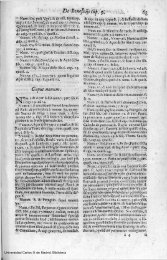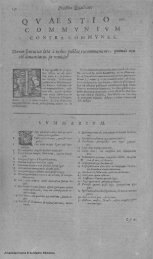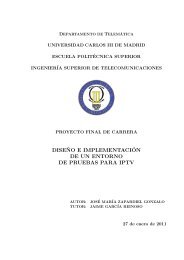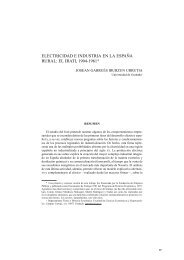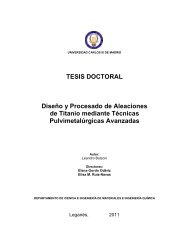Métodos miméticos de pasos fraccionarios - E-Archivo - Universidad ...
Métodos miméticos de pasos fraccionarios - E-Archivo - Universidad ...
Métodos miméticos de pasos fraccionarios - E-Archivo - Universidad ...
Create successful ePaper yourself
Turn your PDF publications into a flip-book with our unique Google optimized e-Paper software.
6 introduction Ch. 1<br />
resulting algorithm (cf. Chapter 5).<br />
The rest of the thesis is organized as follows. In Chapter 2, we consi<strong>de</strong>r a semilinear<br />
problem of type (1.1) with homogeneous Dirichlet boundary conditions.<br />
This chapter is mainly concerned with computational issues and is inten<strong>de</strong>d to<br />
be an introduction to mimetic fractional step methods for subsequent chapters.<br />
In or<strong>de</strong>r to obtain a numerical approximation to the solution of the original<br />
problem, we combine a cell-no<strong>de</strong> MFD method with an FSRKm+1 scheme. In<br />
particular, the mimetic technique consi<strong>de</strong>rs the <strong>de</strong>grees of freedom for ψ to be located<br />
at the geometric centers of the cells, while assuming those for the Cartesian<br />
components of u on the mesh no<strong>de</strong>s. As for the time integration, we introduce a<br />
domain <strong>de</strong>composition operator splitting in combination with a linearly implicit<br />
variant of the well-known Yanenko’s method (cf. Yanenko (1971)). The fully<br />
discrete scheme provi<strong>de</strong>s unconditionally stable solutions which are tested to be<br />
second-or<strong>de</strong>r convergent in space and first-or<strong>de</strong>r convergent in time. The numerical<br />
results further illustrate the behaviour of the algorithm on a collection<br />
of logically rectangular grids.<br />
Based on the preceding discretization techniques, Chapter 3 establishes a<br />
suitable theoretical framework which permits to <strong>de</strong>velop the convergence analysis<br />
for both the semidiscrete and totally discrete schemes. In this case, we<br />
consi<strong>de</strong>r the semilinear problem of the previous chapter with homogeneous Neumann<br />
boundary conditions. Again, a mimetic fractional step method aims to be<br />
constructed for the solution of such a problem. Regarding the spatial semidiscretization,<br />
we introduce a cell-edge MFD scheme whose <strong>de</strong>grees of freedom for<br />
ψ are again <strong>de</strong>fined at the cell centers, while those for u are chosen to be located<br />
at the midpoints of the mesh edges –in fact, they provi<strong>de</strong> an approximation to<br />
the orthogonal projections of u onto the unit vectors normal to the mesh edges.<br />
Note that such <strong>de</strong>grees of freedom are precisely those of the lowest or<strong>de</strong>r Raviart–<br />
Thomas quadrilateral element. This property permits to <strong>de</strong>rive an equivalence<br />
between the MFD scheme and a suitable MFE method, which will be the key to<br />
formulating the convergence analysis of the former within the abstract setting<br />
of the latter. On the other hand, we adapt the domain <strong>de</strong>composition splitting<br />
of the preceding chapter to the newly <strong>de</strong>fined discrete diffusion operator, and<br />
further combine it with a family of linearly implicit FSRKm+1 methods inspired<br />
in the Peaceman–Rachford ADI scheme. The resulting algorithm is shown to<br />
be second-or<strong>de</strong>r convergent in both space and time, while preserving its unconditional<br />
stability. To conclu<strong>de</strong>, the theoretical results are illustrated by some<br />
numerical examples.<br />
Thus far, the problems un<strong>de</strong>r consi<strong>de</strong>ration are posed on polygonal domains<br />
which are likely to be covered with a logically rectangular mesh. In Chapter 4, we<br />
consi<strong>de</strong>r physical domains of general geometry which admit a smooth transformation<br />
into a rectangular computational domain. In this case, (1.1) is endowed<br />
with non-homogeneous Dirichlet boundary conditions. After the original problem<br />
is mapped onto the computational domain, we apply a proper combination<br />
of a CCFD scheme with an FSRKm+1 method based on a component-wise splitting.<br />
More precisely, we first introduce an expan<strong>de</strong>d MFE formulation, which


